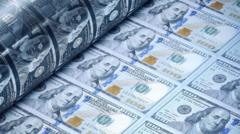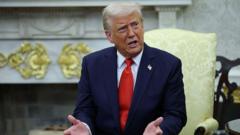The Federal Reserve's recent decision to lower interest rates aims to stabilize the economy amid rising uncertainties from Donald Trump's new presidency.
US Federal Reserve Cuts Interest Rates as Trump's Election Creates Economic Volatility

US Federal Reserve Cuts Interest Rates as Trump's Election Creates Economic Volatility
Interest rate reduction reflects concerns over future inflation linked to Trump's policies.
The U.S. central bank has implemented a fresh cut to its key interest rate, a move that comes in light of the uncertainties introduced by Donald Trump's election as president. The new lending rate now stands at a range of 4.5%-4.75%. This marks the second consecutive decrease following a first drop in over four years back in September, which demonstrates the Fed's belief that inflation rates are beginning to show signs of stabilization.
Economists had anticipated a decline in borrowing costs, yet they caution that Trump's forthcoming proposals on tax policies, immigration reforms, and tariffs may elevate inflation pressures and escalate government debt, complicating the Fed's outlook. This week, the interest rates on government securities surged, underscoring these prevailing anxieties.
The Federal Reserve’s key rate, which affects how much banks charge each other for short-term loans, serves as a crucial benchmark for consumer lending across the economy, impacting rates on credit cards, mortgages, and various loans. Following a period of aggressive rate hikes—aimed at combatting inflation in 2022—that raised the key rate to around 5.3%, the Fed’s recent quarter-point reduction was anticipated.
In reaction to Trump’s victory, the stock market—including U.S. shares and Bitcoin—has surged to unprecedented levels. The Fed indicated that progress has been made in tackling inflation; however, it still remains a bit higher than its 2% target. The central bank emphasized a dual focus on ensuring price stability while maintaining a robust job market, a sentiment consistent with their past discussions. According to the latest figures, U.S. inflation fell to 2.4% in September, down from over 9% recorded just a year prior in June 2022.
Economists had anticipated a decline in borrowing costs, yet they caution that Trump's forthcoming proposals on tax policies, immigration reforms, and tariffs may elevate inflation pressures and escalate government debt, complicating the Fed's outlook. This week, the interest rates on government securities surged, underscoring these prevailing anxieties.
The Federal Reserve’s key rate, which affects how much banks charge each other for short-term loans, serves as a crucial benchmark for consumer lending across the economy, impacting rates on credit cards, mortgages, and various loans. Following a period of aggressive rate hikes—aimed at combatting inflation in 2022—that raised the key rate to around 5.3%, the Fed’s recent quarter-point reduction was anticipated.
In reaction to Trump’s victory, the stock market—including U.S. shares and Bitcoin—has surged to unprecedented levels. The Fed indicated that progress has been made in tackling inflation; however, it still remains a bit higher than its 2% target. The central bank emphasized a dual focus on ensuring price stability while maintaining a robust job market, a sentiment consistent with their past discussions. According to the latest figures, U.S. inflation fell to 2.4% in September, down from over 9% recorded just a year prior in June 2022.





















